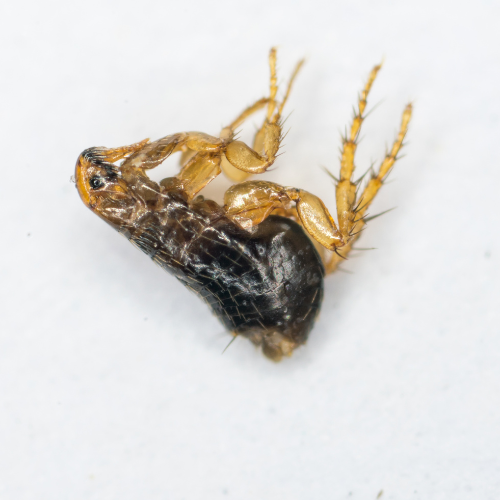Cat Flea

Introduction to
Cat fleas, scientifically known as Ctenocephalides felis, are one of the most common ectoparasites affecting pets, particularly cats and dogs. These tiny, wingless insects are notorious for their itchy bites and their ability to transmit various diseases and parasites, including tapeworms. Understanding the biology, habits, and effective prevention methods for cat fleas is crucial for pet owners and anyone living with pets. Effective flea control not only ensures the comfort and health of pets but also helps maintain a flea-free environment in the home.
Recognition
Cat fleas are small, wingless insects, typically measuring about 1 to 3 mm in length. They have a reddish-brown color and laterally compressed bodies, which allow them to move easily through the fur of their hosts. Cat fleas have long hind legs adapted for jumping, which they use to transfer between hosts. Their bodies are covered with spines and hairs that help them cling to the host’s fur. Unlike other flea species, cat fleas have a distinct row of comb-like spines on their head and thorax, aiding in identification. Their presence is often indicated by the scratching and biting behavior of infested pets.
Biology
Cat fleas undergo complete metamorphosis, progressing through four life stages: egg, larva, pupa, and adult. Female fleas lay eggs on the host, which then fall off into the environment, such as bedding, carpets, and furniture. These eggs hatch into larvae that feed on organic debris and flea feces. The larvae then spin cocoons and pupate, emerging as adults when conditions are favorable. Adult fleas feed on the blood of their hosts, and females can lay several dozen eggs per day, leading to rapid population growth. Cat fleas can live for several weeks to months, depending on environmental conditions and the availability of hosts.
Habits
Cat fleas prefer to infest cats and dogs but will also bite humans if necessary. They thrive in warm, humid environments and are commonly found in households with pets. Flea larvae develop in areas where pets sleep and spend time, such as pet bedding, carpets, and upholstery. Adult fleas spend most of their time on the host, feeding and reproducing. They are attracted to the host by body heat, movement, and carbon dioxide. Fleas can cause severe itching and discomfort for pets, and heavy infestations can lead to anemia, especially in young or small animals.
Prevention
Preventing cat flea infestations involves a combination of pet care and environmental control. Regularly treat pets with veterinarian-recommended flea control products, such as topical treatments, oral medications, or flea collars. Bathe pets with flea shampoos and use flea combs to remove fleas and their eggs from the fur. Vacuum carpets, rugs, and furniture frequently to remove eggs, larvae, and pupae from the environment. Wash pet bedding and soft furnishings in hot water regularly. Maintaining good hygiene and cleanliness in the home is essential to break the flea lifecycle and prevent re-infestations.
Professional
If cat fleas become a persistent problem, professional pest control services can provide effective solutions. STL Pest Control offers comprehensive treatments to eliminate flea populations from the home and yard. Their technicians are trained to identify flea hotspots and apply appropriate insecticides and growth regulators to target all life stages of the flea. In severe infestations, they may recommend ongoing maintenance plans to keep the environment flea-free. Professional services ensure thorough and long-lasting control, providing peace of mind and a healthier living space for pets and their owners.



Our Office






